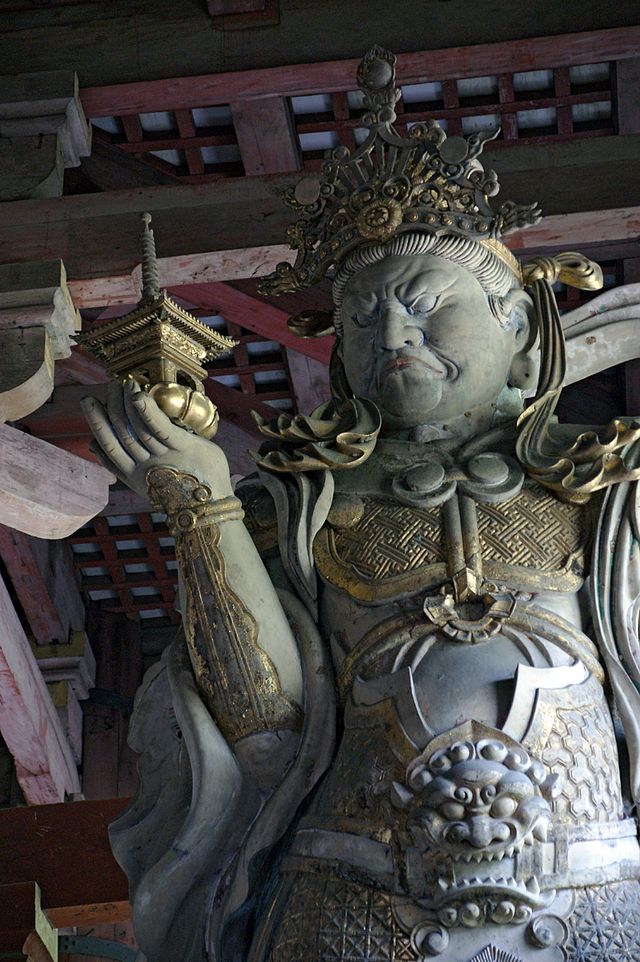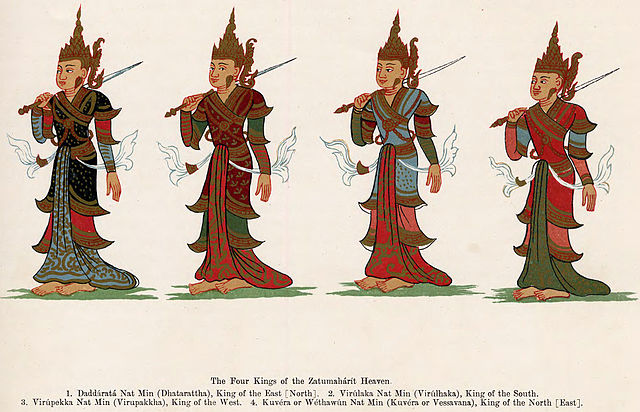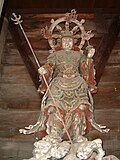Top Qs
Timeline
Chat
Perspective
Four Heavenly Kings
Buddhist gods From Wikipedia, the free encyclopedia
Remove ads
The Four Heavenly Kings are four Buddhist gods or devas, each of whom is believed to watch over one cardinal direction of the world. The Hall of Four Heavenly Kings is a standard component of Chinese Buddhist temples. The Four Heavenly Kings (Sanskrit Caturmahārāja, Pali Catu-Mahārāja, Chinese Sì Dà Tiānwáng 四大天王, Japanese Shitennō 四天王) are celestial deities or guardian gods in Buddhist cosmology who preside over the four cardinal directions and protect the Dharma.[1]


Remove ads
Cosmological role
In Buddhist cosmology, the Four Heavenly Kings dwell on the lower slopes of Mount Sumeru in the heaven known as Cāturmahārājakāyika (the realm of the Four Great Kings).[2] They act as subordinate deities of Śakra (Indra) in the Trāyastriṃśa realm and are tasked with guarding the four directions and protecting the world from malevolent forces.[3]
In the Sutra of Golden Light (Suvarṇabhāsottamasūtra), the Four Heavenly Kings vow to protect those who honor and recite the sutra, thereby safeguarding righteous rulers and the Buddhist sangha.[4]
They also appear in protective discourses such as the Āṭānāṭīya Sutta (Dīgha Nikāya 32), where one of the kings (Vessavaṇa / Vaiśravaṇa) gives protective verses against malicious spirits.[5]
Remove ads
Individual kings and attributes
Each king corresponds to a cardinal direction and leads classes of lesser spirits or beings. Their names and roles vary slightly across Buddhist traditions.
In East Asian Buddhist art, these kings are depicted in armor, wielding symbolic objects (lute, sword, serpent, umbrella or stupa), and standing in fierce warrior poses.[10]
Remove ads
Literary and ritual significance
Golden Light Sutra and state protection
One of the most influential sutras linking the Four Heavenly Kings to political and religious legitimacy is the Golden Light Sutra. It was widely employed in East Asia as a state-protection text: rulers would commission recitations to invoke the protector deities, including the Four Heavenly Kings, to defend the realm from disasters, invasions, or internal disorder.[4]
In particular, Emperor Shōmu of Nara Japan (8th century) ordered the construction of provincial temples, each enshrining a copy of the text, naming them “Temples for the Protection of the State by the Golden Light of the Four Heavenly Kings.”[4]
Protective sūtras and recitations
The Scripture of the Four Heavenly Kings (Si Tianwang Jing, T.590) is another text in the East Asian canon describing the kings' protective functions. Scholars have observed that parts of this scripture contain strongly secular or non-Buddhist elements.[11]
Iconographic and regional variations
- In Chinese Buddhism, the Four Kings are often enshrined in the Heavenly Kings Hall (天王殿) at temple entrances.[12]
- In Japanese Buddhism, known as Shitennō, they guard temple gates or surround the main deity in martial stances.[13]
- In Korean Buddhism, the Four Heavenly Kings at Hwaomsa (Gurye) have been studied, with attribution to the 17th-century sculptor monk In’gyun.[14]
The standardized iconography (lute, sword, snake, parasol) crystallized in China under Tibetan Tantric influence.[10]
Remove ads
Symbolic interpretation
The Four Heavenly Kings are commonly interpreted as symbolizing:
- Guardianship of the Dharma – protecting the world from negative influences.[1]
- Cosmic order – maintaining harmony in the universe through control of directions.
- Support of rulers – legitimizing righteous kingship through divine protection.[4]
Names
Summarize
Perspective
The Kings are collectively named as follows:
Individually, they have different names and features.
| Pali name | Vessavaṇa | Virūḷhaka | Dhataraṭṭha | Virūpakkha |
| Devanagari Sanskrit romanization |
वैश्रवण (कुबेर) Vaiśravaṇa (Kubera) |
विरूढक Virūḍhaka |
धृतराष्ट्र Dhṛtarāṣṭra |
विरूपाक्ष Virūpākṣa |
| Meaning | He who hears everything | He who causes to grow | He who upholds the realm | He who sees all |
| Control | yakṣas/yakkhas | kumbhāṇḍhas/kumbhaṇḍhas | gandharvas/gandhabbas | nāgas |
| Description | This is the chief of the four kings and protector of the north. He is the ruler of rain. His symbolic weapons are the umbrella or pagoda. Wearing heavy armor and carrying the umbrella in his right hand, he is often associated with the ancient Hindu god of wealth, Kubera. Associated with the color yellow or green. | King of the south and one who causes good growth of roots. He is the ruler of the wind. His symbolic weapon is the sword which he carries in his right hand to protect the Dharma and the southern continent. Associated with the color blue. | King of the east and god of music. His symbolic weapon is the pipa (stringed instrument). He is harmonious and compassionate and protects all beings. Uses his music to convert others to Buddhism. Associated with the color white. | King of the west and one who sees all. His symbolic weapon is a snake or red cord that is representative of a dragon. As the eye in the sky, he sees people who do not believe in Buddhism and converts them. His ancient name means "he who has broad objectives". Associated with the color red |
| Image |  |
 |
 |
 |
| Color | yellow or green | blue | white | red |
| Symbol | umbrella | sword | pipa | serpent |
| mongoose | stupa | |||
| stupa | pearl | |||
| Followers | yakṣas | kumbhāṇḍas | gandharvas | nāgas |
| Direction | north | south | east | west |
| Traditional/Simplified Chinese Pinyin |
多聞天王 / 多闻天王 Duōwén Tiānwáng |
增長天王 / 增长天王 Zēngzhǎng Tiānwáng |
持國天王 / 持国天王 Chíguó Tiānwáng |
廣目天王 / 广目天王 Guăngmù Tiānwáng |
| 毗沙門天 / 毗沙门天 | 留博叉天 / 留博叉天 | 多羅吒天 / 多罗吒天 | 毗琉璃天 / 毗琉璃天 | |
| Kanji Hepburn romanization |
多聞天 (毘沙門天) Tamon-ten (Bishamon-ten) |
増長天 Zōchō-ten |
持国天 Jikoku-ten |
広目天 Kōmoku-ten |
| 治国天 Jikoku-ten | ||||
| Hangul romanized Korean |
다문천왕 Damun-cheonwang |
증장천왕 增長天王 Jeungjang-cheonwang |
지국천왕 持國天王 Jiguk-cheonwang |
광목천왕 廣目天王 Gwangmok-cheonwang |
| Vietnamese alphabet Chữ Hán |
Đa Văn Thiên Vương 多聞天王 |
Tăng Trưởng Thiên Vương 增長天王 |
Trì Quốc Thiên Vương 持國天王 |
Quảng Mục Thiên Vương 廣目天王 |
| Burmese Script | ဝေဿဝဏ္ဏနတ်မင်း (Wethawun Nat Min) ကုဝေရနတ်မင်း (Kuwera Nat Min) |
ဝိရူဠကနတ်မင်း (Wirulakka Nat Min) | ဓတရဋ္ဌနတ်မင်း (Datarattha Nat Min) | ဝိရူပက္ခနတ်မင်း (Wirupakkha Nat Min) |
| Tibetan alphabet and romanization | རྣམ་ཐོས་སྲས་ (Namthöse) | ཕགས་སྐྱེས་པོ་ (Phakyepo) | ཡུལ་འཁོར་སྲུང་ (Yülkhorsung) | སྤྱན་མི་བཟང་ (Chenmizang) |
| Mongolian Script and Mongolian Cyrillic and Mongolian Latin alphabet | ᠲᠡᠢᠨ ᠰᠣᠨᠣᠰᠤᠭᠴᠢ
(Тийн сонсогч) Tiin sonsogch/tein sonosuɣči |
ᠦᠯᠡᠮᠵᠢ ᠪᠡᠶᠡᠲᠦ
(Үлэмж биет) Ülemzh biyet/Ülemji beyetü |
ᠣᠷᠣᠨ ᠣᠷᠴᠢᠨ ᠢ ᠰᠠᠬᠢᠭᠴᠢ
(Орон орчиниг сахигч) Oron orchinig saxigch/Oron orčin-i sakiɣči |
ᠡᠭᠡᠨᠡᠭᠲᠡ ᠦᠵᠡᠭᠴᠢ
(Эгнэгт үзэгч) Egnegt üzegch/Egenegte üjegči |
| (Намсрай)
Namsrai |
(Пагжийбуу)
Pagzhiibuu |
(Ёлхорсүрэн)
Yolxorsüren |
(Жамийсан)
Zhamiisan | |
| ᠥᠯᠥᠨ ᠦᠨᠳᠡᠰᠲᠨᠢᠢ ᠦᠽᠡᠯ (Олон үндэстний үзэл) Olon ündestnii üzel |
ᠲᠢᠶᠡᠨᠢ ᠥᠰᠥᠯᠲ (Тиений өсөлт) Tiyenii ösölt |
ᠦᠨᠳᠡᠰᠲᠨᠢᠢ ᠽᠠᠰᠤᠠᠷ ᠦᠯᠢᠴᠬᠢᠯᠭᠡᠡ (үндэсний засвар үйлчилгээ) ündesnii zasvar üilchilgee |
ᠰᠶᠡᠯᠶᠡᠰᠲᠢᠶᠡᠯ ᠰᠦᠷᠲᠠᠯᠴᠬᠢᠯᠭᠠᠠ (селестиел сурталчилгаа) syelyestiyel surtalchilgaa | |
| Thai script romanization |
ท้าวเวสวัณ (Thao Wetsawan) ท้าวเวสสุวรรณ (Thao Wetsuwan) ท้าวกุเวร (Thao Kuwen) |
ท้าววิรุฬหก (Thao Wirunhok) | ท้าวธตรฐ (Thao Thatarot) | ท้าววิรูปักษ์ (Thao Wirupak) |
- Four Heavenly Kings statues at the royal crematorium of King Bhumibol Adulyadej of Thailand
- Vaiśravaṇa of the north direction, king of yakṣas.
- Virūḍhaka of the south direction, king of kumbhāṇḍas.
- Dhṛtarāṣṭra of the east direction, king of gandharvas.
- Virūpākṣa of the west direction, king of nāgas.
Remove ads
Mythology
Summarize
Perspective
All four Kings serve Śakra, the lord of the devas of Trāyastriṃśa. On the 8th, 14th and 15th days of each lunar month, the Kings either send out emissaries or go themselves to inspect the state of virtue and morality in the world of men. Then they report their findings to the assembly of the Trāyastriṃśa devas.
On the orders of Śakra, the Kings and their retinues stand guard to protect Trāyastriṃśa from another attack by the Asuras, which once threatened to destroy the realm of the devas. They also vowed to protect the Buddha, the Dharma, and the Buddha's followers from danger. In Chinese Buddhism, all four of the heavenly kings are regarded as four of the Twenty Devas (二十諸天 Èrshí Zhūtiān) or the Twenty-Four Devas (二十四諸天 Èrshísì zhūtiān), a group of Buddhist dharmapalas who manifest to protect the Dharma.[15]

According to Vasubandhu, devas born in the Cāturmahārājika heaven are 1/4 of a krośa in height (about 750 feet tall). They have a five-hundred-year lifespan, of which each day is equivalent to 50 years in our world; thus their total lifespan amounts to about nine million years (other sources say 90,000 years).

The attributes borne by each King also link them to their followers; for instance, the nāgas, magical creatures who can change form between human and serpent, are led by Virūpākṣa, represented by a snake; the gandharvas are celestial musicians, led by Dhṛtarāṣṭra, represented with a lute. The umbrella was a symbol of regal sovereignty in ancient India, and the sword is a symbol of martial prowess. Vaiśravaṇa's mongoose, which ejects jewels from its mouth, is said to represent generosity in opposition to greed.
| Vaiśravaṇa
(north) |
||
| Virūpākṣa
(west) |
Heavenly Kings | Dhṛtarāṣṭra
(east) |
| Virūḍhaka
(south) |
Remove ads
Gallery
- Statues of the Four Heavenly Kings of Lingyin Temple, Hangzhou, Zhejiang, China.
- Duowen Tianwang (north)
- Zengzhang Tianwang (south)
- Chiguo Tianwang (east)
- Guangmu Tianwang (west)
Popular culture
The motif of the Four Heavenly Kings has been appropriated in secular contexts. In Japanese history, the term Shitennō referred to four powerful generals, e.g. the Four Heavenly Kings of Tokugawa.[16] In modern media (anime, manga, video games), the Four Heavenly Kings are reimagined as elite guardians or adversaries.
- In Japanese professional wrestling, the group of Mitsuharu Misawa, Kenta Kobashi, Toshiaki Kawada, and Akira Taue of All Japan Pro-Wrestling are commonly referred to as the Four Heavenly Kings of Pro Wrestling.
- In the Hong Kong entertainment industry, Andy Lau, Jacky Cheung, Leon Lai, Aaron Kwok are known as the Four Heavenly Kings.
- In the mid-to-late 1990s, Malice Mizer, La'cryma Christi, Fanatic Crisis and Shazna were known as the Four Heavenly Kings of the visual kei scene.[17][18]
- In MegaBeast Investigator Juspion (1985), starting in episode 13, the main villain Mad Gallant employs a quartet of assassins called the Four Evil Heavenly Kings (悪の四天王, Aku no Shitennō).
- In Street Fighter II (1991), the leading members of Shadaloo (Grand Masters in English) are known as the Four Heavenly Kings. They consist of M. Bison (Vega in Japanese), Vega (Balrog in Japanese), Balrog (M. Bison in Japanese), Sagat (formerly), and F.A.N.G.
- In Sailor Moon (1991), the Four Heavenly Kings were the four loyal and faithfully devoted generals and bodyguards of Prince Endymion.
- In Pokémon (1996), the group of Pokémon trainers known as the Elite Four in English are called the Four Heavenly Kings in Japanese, Chinese and Korean.
- In Mega Man Zero (2002), the group of Reploids known as the Four Guardians in English are called the Four Heavenly Kings in Japanese. In the crossover game Rockman Xover, there is another group also called the Four Heavenly Kings.
- In Toriko (2008), the four protagonists, adopted sons of Ichiryu (Toriko, Coco, Sunny and Zebra), are known as the Four Heavenly Kings.
- The third Detective Dee film by Tsui Hark is titled Detective Dee: The Four Heavenly Kings (2018).
- In Black Myth: Wukong (2024), the Four Heavenly Kings are featured as a boss fight.
Remove ads
See also
References
External links
Wikiwand - on
Seamless Wikipedia browsing. On steroids.
Remove ads












